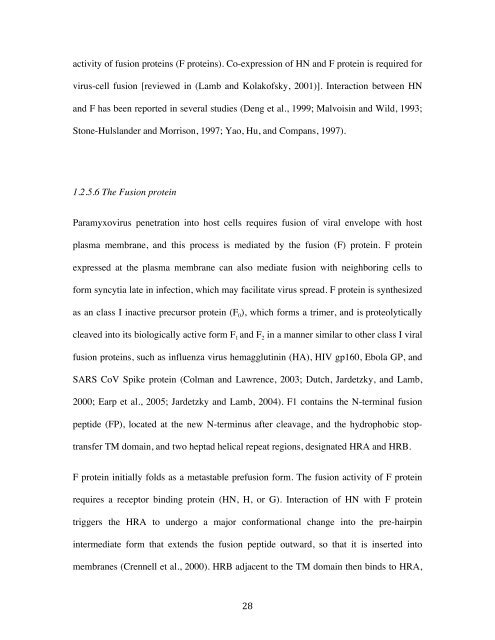Han Xiao PhD thesis - Research@StAndrews:FullText - University of ...
Han Xiao PhD thesis - Research@StAndrews:FullText - University of ...
Han Xiao PhD thesis - Research@StAndrews:FullText - University of ...
Create successful ePaper yourself
Turn your PDF publications into a flip-book with our unique Google optimized e-Paper software.
activity <strong>of</strong> fusion proteins (F proteins). Co-expression <strong>of</strong> HN and F protein is required for<br />
virus-cell fusion [reviewed in (Lamb and Kolak<strong>of</strong>sky, 2001)]. Interaction between HN<br />
and F has been reported in several studies (Deng et al., 1999; Malvoisin and Wild, 1993;<br />
Stone-Hulslander and Morrison, 1997; Yao, Hu, and Compans, 1997).<br />
1.2.5.6 The Fusion protein <br />
Paramyxovirus penetration into host cells requires fusion <strong>of</strong> viral envelope with host<br />
plasma membrane, and this process is mediated by the fusion (F) protein. F protein<br />
expressed at the plasma membrane can also mediate fusion with neighboring cells to<br />
form syncytia late in infection, which may facilitate virus spread. F protein is synthesized<br />
as an class I inactive precursor protein (F 0 ), which forms a trimer, and is proteolytically<br />
cleaved into its biologically active form F 1 and F 2 in a manner similar to other class I viral<br />
fusion proteins, such as influenza virus hemagglutinin (HA), HIV gp160, Ebola GP, and<br />
SARS CoV Spike protein (Colman and Lawrence, 2003; Dutch, Jardetzky, and Lamb,<br />
2000; Earp et al., 2005; Jardetzky and Lamb, 2004). F1 contains the N-terminal fusion<br />
peptide (FP), located at the new N-terminus after cleavage, and the hydrophobic stoptransfer<br />
TM domain, and two heptad helical repeat regions, designated HRA and HRB.<br />
F protein initially folds as a metastable prefusion form. The fusion activity <strong>of</strong> F protein<br />
requires a receptor binding protein (HN, H, or G). Interaction <strong>of</strong> HN with F protein<br />
triggers the HRA to undergo a major conformational change into the pre-hairpin<br />
intermediate form that extends the fusion peptide outward, so that it is inserted into<br />
membranes (Crennell et al., 2000). HRB adjacent to the TM domain then binds to HRA,<br />
<br />
28
















